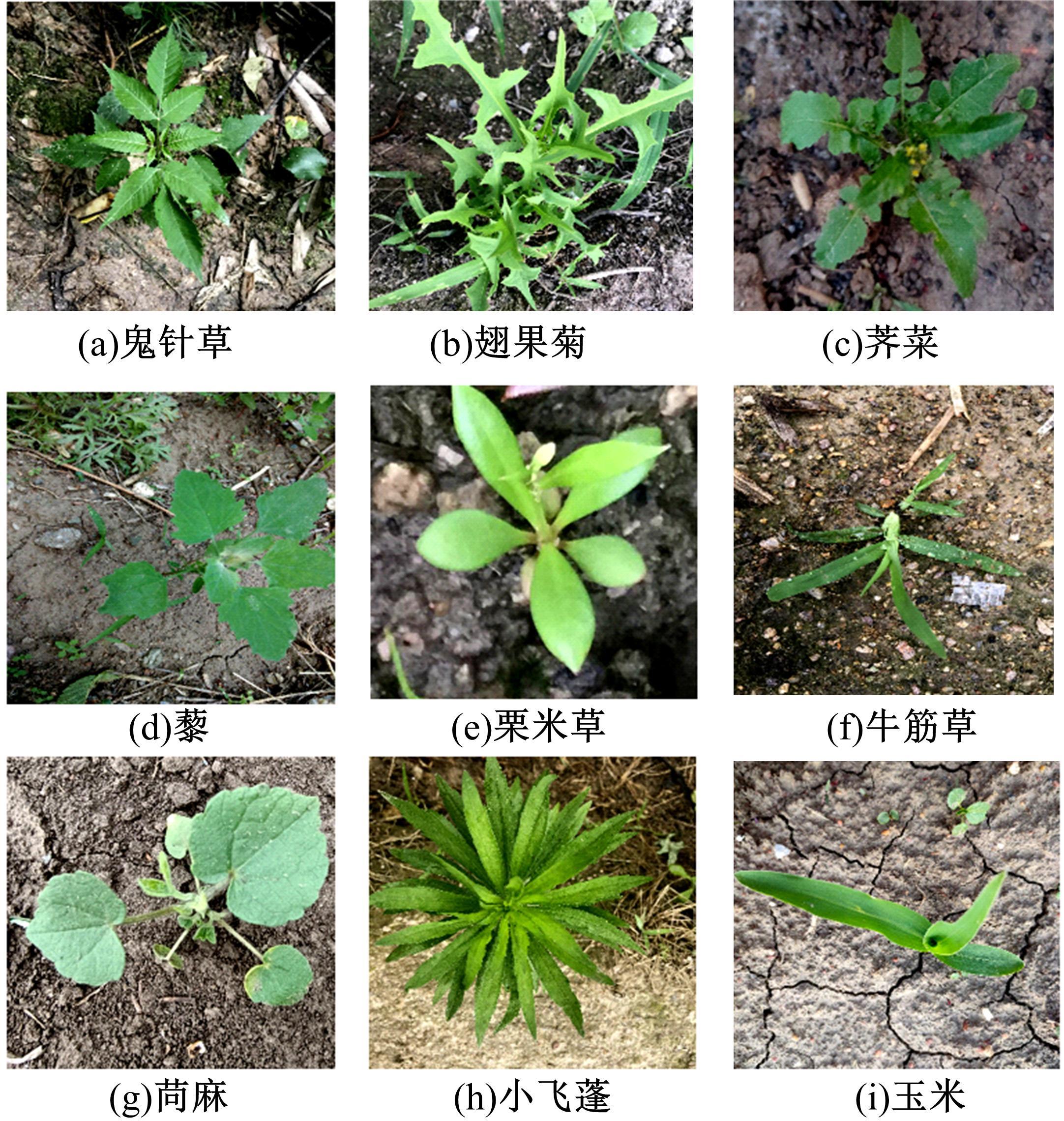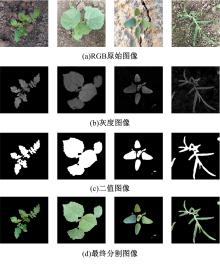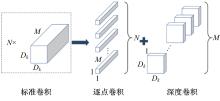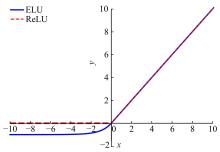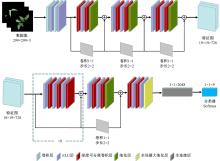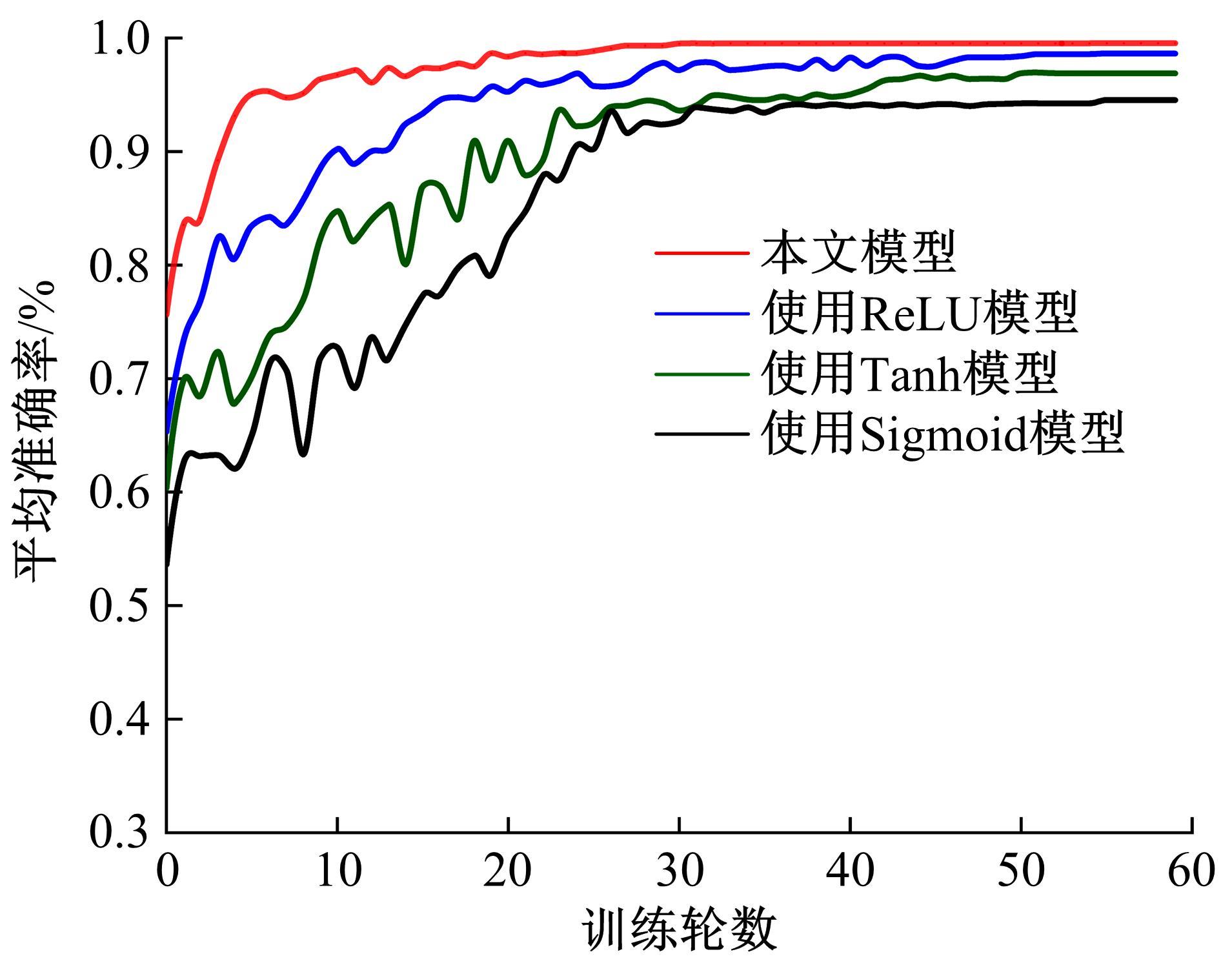吉林大学学报(工学版) ›› 2021, Vol. 51 ›› Issue (6): 2304-2312.doi: 10.13229/j.cnki.jdxbgxb20200733
• 农业工程·仿生工程 • 上一篇
基于轻量卷积网络的田间自然环境杂草识别方法
- 吉林农业大学 信息技术学院,长春 130118
Weed identification method based on deep transfer learning in field natural environment
Yan-lei XU( ),Run HE,Yu-ting ZHAI,Bin ZHAO,Chen-xiao LI(
),Run HE,Yu-ting ZHAI,Bin ZHAO,Chen-xiao LI( )
)
- College of Information Technology,Jilin Agricultural University,Changchun 130118,China
摘要:
针对田间自然环境下杂草识别精度低和检测速度慢的问题,本文依据自然环境杂草图像数据的特性,在Xception卷积网络的基础上构建了一种基于轻量卷积网络的杂草识别模型。首先改进Xception模型,采用ELU作为模型的激活函数,并使用全局最大池化层对最后一层卷积进行下采样。然后,对原始数据进行背景分割和数据增强处理,在迁移后的模型上继续微调,训练得到最佳的杂草识别模型。在相同的试验条件下,与VGG16、VGG19、ResNet50和Inception-V3四种标准的深度卷积网络模型进行比较,结果显示,本文模型的整体性能最好,对自然条件下8类杂草及苗期玉米的平均测试识别准确率高达98.63%,改进模型的规模为83.5 MB,单张杂草图像检测平均耗时仅为63.8 ms。本文研究结果可为田间自然环境下精准喷药的实施提供理论基础和技术支持。
中图分类号:
- TP183
| 1 | 李秉华,张永信,边全乐,等. 免耕夏玉米田杂草防治关键期研究[J]. 中国生态农业学报, 2013, 21(8): 998-1003. |
| Li Bing-hua, Zhang Yong-xin, Bian Quan-le, et al. Critical period of weed control in no-tillage summer maize fields[J]. Chinese Journal of Eco-Agriculture, 2013, 21(8): 998-1003. | |
| 2 | 李涛, 温广月, 钱振官, 等.不同类型杂草危害对小麦产量的影响[J]. 中国植保导刊, 2013, 33(4): 28-30. |
| Li Tao, Wen Guang-yue, Qian Zhen-guan, et al. The influence on wheat yield loss caused by different kinds of weeds[J]. China Plant Protection, 2013, 33(4): 28-30. | |
| 3 | 殷连平. 杂草与病虫害[J]. 植物检疫, 1998,19(2): 109-111. |
| Yin Lian-ping. Weeds and pests and diseases[J]. Plant Quarantine, 1998, 19(2): 109-111. | |
| 4 | 李香菊. 近年我国农田杂草防控中的突出问题与治理对策[J]. 植物保护, 2018, 44(5): 77-84. |
| Li Xiang-ju. Main problems and management strategies of weeds in agricultural fields in China in recent years[J]. Plant Protection, 2018, 44(5): 77-84. | |
| 5 | Janc K, Czapiewski K, Wójcik M. In the starting blocks for smart agriculture: The internet as a source of knowledge in transitional agriculture[J]. NJAS-Wageningen Journal of Life Sciences, 2019, (90/91): No. 100309. |
| 6 | 徐艳蕾,包佳林,付大平,等. 多喷头组合变量喷药系统的设计与试验[J]. 农业工程学报, 2016, 32(17): 47-54. |
| Xu Yan-lei, Bao Jia-lin, Fu Da-ping, et al. Design and experiment of variable spraying system based on multiple combined nozzles[J]. Transactions of the Chinese Society of Agricultural Engineering, 2016, 32 (17): 47-54. | |
| 7 | 张小龙,谢正春,张念生,等. 豌豆苗期田间杂草识别与变量喷洒控制系统[J]. 农业机械学报, 2012, 43(11):220-225, 73. |
| Zhang Xiao-long, Xie Zheng-chun, Zhang Nian-sheng, et al. Weed recognition from pea seedling images and variable spraying control system[J]. Transactions of the Chinese Society for Agricultural Machinery, 2012, 43(11): 220-225, 73. | |
| 8 | 毛文华, 王一鸣, 张小超, 等. 基于机器视觉的田间杂草识别技术研究进展[J]. 农业工程学报, 2004, 20(5): 43-46. |
| Mao Wen-hua, Wang Yi-ming, Zhang Xiao-chao, et al. Research advances of weed identification technology usingmachine vision[J]. Transactions of the Chinese Society of Agricultural Engineering, 2004, 20(5): 43-46. | |
| 9 | 颜秉忠. 机器视觉技术在玉米苗期杂草识别中的应用[J]. 农机化研究, 2018, 40(3): 212-216. |
| Yan Bing-zhong. Identification of weeds in maize seedling stage by machine vision technology[J]. Journal of Agricultural Mechanization Research, 2018, 40(3): 212-216. | |
| 10 | 王宏艳,吕继兴. 基于纹理特征与改进SVM算法的玉米田间杂草识别[J]. 湖北农业科学, 2014, 53(13): 3163-3166, 3169. |
| Wang Hong-yan, Lv Ji-xing. Identifying corn weed based on texture features and optimized SVM[J]. Hubei Agricultural Sciences, 2014, 53(13): 3163-3166, 3169. | |
| 11 | Lottes P, Hrferlin M, Sander S, et al. Effective vision‐based classification for separating sugar beets and weeds for precision farming[J]. Journal of Field Robotics, 2017, 34(6): 1160-1178. |
| 12 | Lavania S, Matey P S. Novel method for weed classification in maize field using Otsu and PCA implementation[C]∥2015 IEEE International Conference on Computational Intelligence & Communication Technology, Ghaziabad, India, 2015: 534-537. |
| 13 | Wang Z B, Li H, Zhu Y, et al. Review of plant identification based on image processing[J]. Archives of Computational Methods in Engineering, 2017, 24(3): 637-654. |
| 14 | Rojas C P, Guzmán L S, Toledo N V. Weed recognition by SVM texture feature classification in outdoor vegetable crops images[J]. Ingeniería e Investigación, 2017, 37(1): 68-74. |
| 15 | 张新明,涂强,冯梦清. 基于改进概率神经网络的玉米与杂草识别[J]. 山西大学学报: 自然科学版, 2015, 38(3): 432-438. |
| Zhang Xin-ming, Tu Qiang, Feng Meng-qing. Weed identification method from corn based on improved probabilistic neural network[J]. Journal of Shanxi University(Natural Science Edition), 2015, 38(3): 432-438. | |
| 16 | 姜红花,王鹏飞,张昭,等. 基于卷积网络和哈希码的玉米田间杂草快速识别方法[J]. 农业机械学报, 2018, 49(11): 30-38. |
| Jiang Hong-hua,Wang Peng-fei,Zhang Zhao,et al. Fast identification of field weeds based on deep convolutional network and binary hash code[J]. Transactions of the Chinese Society for Agricultural Machinery, 2018, 49(11): 30-38. | |
| 17 | 邓向武,齐龙,马旭,等. 基于多特征融合和深度置信网络的稻田苗期杂草识别[J]. 农业工程学报, 2018, 34(14): 165-172. |
| Deng Xiang-wu, Qi Long, Ma Xu, et al. Recognition of weeds at seedling stage in paddy fields using multi-feature fusion and deep belief networks[J]. Transactions of the Chinese Society of Agricultural Engineering, 2018, 34(14): 165-172. | |
| 18 | Yu J L, Schumann A W, Cao Z, et al. Weed detection in perennial ryegrass with deep learning convolutional neural network[J]. Frontiers in Plant Science, 2019, 10: 1422. |
| 19 | Yu J, Sharpe S M, Schumann A W, et al. Detection of broadleaf weeds growing in turfgrass with convolutional neural networks[J]. Pest Management Science, 2019, 75(8): 2211-2218. |
| 20 | 刘庆飞. 农业场景下卷积神经网络的应用研究[D]. 乌鲁木齐:新疆大学电气工程学院,2019. |
| Liu Qing-fei. Application research of convolutional neural network in agricultural scene[D]. Urumqi: School of Electrical Engineering, Xinjiang University, 2019. | |
| 21 | Wang A C, Zhang W, Wei X H. A review on weed detection using ground-based machine vision and image processing techniques[J]. Computers and Electronics in Agriculture, 2019, 158: 226-240. |
| 22 | Razavi S, Yalcin H. Using convolutional neural networks for plant classification[C]∥2017 25th Signal Processing and Communications Applications Conference, Antalya, Turkey, 2017: 1-4. |
| 23 | 孙俊,何小飞,谭文军,等. 空洞卷积结合全局池化的卷积神经网络识别作物幼苗与杂草[J]. 农业工程学报, 2018, 34(11): 159-165. |
| Sun Jun,He Xiao-fei,Tan Wen-jun,et al. Recognition of crop seedling and weed recognition based on dilated convolution and global pooling in CNN[J]. Transactions of the Chinese Society of Agricultural Engineering,2018, 34(11): 159-165. | |
| 24 | 王淑芬, 杨玲香. 基于GA-ANN融合算法的棉田杂草特征降维及分类识别[J]. 河南农业科学,2018,47(2):148-154, 160. |
| Wang Shu-fen, Yang Ling-xiang. Feature dimension reduction and category identification of weeds in cotton field based on GA-ANN complex algorithm[J]. Journal of Henan Agricultural Sciences, 2018, 47(2):148-154, 160. | |
| 25 | Jia Shi-jie, Wang Ping, Jia Pei-yi, et al. Research on data augmentation for image classification based on convolution neural networks[C]∥2017 Chinese Automation Congress, Jinan, China, 2017:4165-4170. |
| 26 | Chollet F. Xception:deep learning with depthwise separable convolutions[C]∥Proceedings of the IEEE Conference on Computer Vision and Pattern Recognition, Honolulu, HI, USA, 2017: 1251-1258. |
| 27 | Szegedy C, Vanhoucke V, Ioffe S, et al. Rethinking the inception architecture for computer vision[C]∥Proceedings of the IEEE conference on computer vision and pattern recognition, Las Vegas, NV, USA, 2016: 2818-2826. |
| 28 | 陈绵书,于录录,苏越,等. 基于卷积神经网络的多标签图像分类[J]. 吉林大学学报: 工学版, 2020, 50(3): 1077-1084. |
| Chen Mian-shu,Yu Lu-lu,Su Yue,et al. Multi-label images classification based on convolutional neural network[J]. Journal of Jilin University(Engineering and Technology Edition), 2020, 50(3): 1077-1084. | |
| 29 | 张根保,李浩,冉琰,等. 一种用于轴承故障诊断的迁移学习模型[J]. 吉林大学学报: 工学版, 2020, 50(5): 1617-1626. |
| Zhang Gen-bao, Li Hao, Ran Yan, et al. A transfer learning model for bearing fault diagnosis[J]. Journal of Jilin University(Engineering and Technology Edition), 2020, 50(5): 1617-1626. |
| [1] | 欧阳丹彤,张必歌,田乃予,张立明. 结合格局检测与局部搜索的故障数据缩减方法[J]. 吉林大学学报(工学版), 2021, 51(6): 2144-2153. |
| [2] | 杨勇,陈强,曲福恒,刘俊杰,张磊. 基于模拟划分的SP⁃k⁃means-+算法[J]. 吉林大学学报(工学版), 2021, 51(5): 1808-1816. |
| [3] | 赵亚慧,杨飞扬,张振国,崔荣一. 基于强化学习和注意力机制的朝鲜语文本结构发现[J]. 吉林大学学报(工学版), 2021, 51(4): 1387-1395. |
| [4] | 董延华,刘靓葳,赵靖华,李亮,解方喜. 基于BPNN在线学习预测模型的扭矩实时跟踪控制[J]. 吉林大学学报(工学版), 2021, 51(4): 1405-1413. |
| [5] | 刘富,梁艺馨,侯涛,宋阳,康冰,刘云. 模糊c-harmonic均值算法在不平衡数据上改进[J]. 吉林大学学报(工学版), 2021, 51(4): 1447-1453. |
| [6] | 尚福华,曹茂俊,王才志. 基于人工智能技术的局部离群数据挖掘方法[J]. 吉林大学学报(工学版), 2021, 51(2): 692-696. |
| [7] | 赵海英,周伟,侯小刚,张小利. 基于多任务学习的传统服饰图像双层标注[J]. 吉林大学学报(工学版), 2021, 51(1): 293-302. |
| [8] | 张根保,李浩,冉琰,李裘进. 一种用于轴承故障诊断的迁移学习模型[J]. 吉林大学学报(工学版), 2020, 50(5): 1617-1626. |
| [9] | 欧阳丹彤,马骢,雷景佩,冯莎莎. 知识图谱嵌入中的自适应筛选[J]. 吉林大学学报(工学版), 2020, 50(2): 685-691. |
| [10] | 李贻斌,郭佳旻,张勤. 人体步态识别方法与技术[J]. 吉林大学学报(工学版), 2020, 50(1): 1-18. |
| [11] | 徐谦,李颖,王刚. 基于深度学习的行人和车辆检测[J]. 吉林大学学报(工学版), 2019, 49(5): 1661-1667. |
| [12] | 高万夫,张平,胡亮. 基于已选特征动态变化的非线性特征选择方法[J]. 吉林大学学报(工学版), 2019, 49(4): 1293-1300. |
| [13] | 欧阳丹彤,肖君,叶育鑫. 基于实体对弱约束的远监督关系抽取[J]. 吉林大学学报(工学版), 2019, 49(3): 912-919. |
| [14] | 顾海军, 田雅倩, 崔莹. 基于行为语言的智能交互代理[J]. 吉林大学学报(工学版), 2018, 48(5): 1578-1585. |
| [15] | 董飒, 刘大有, 欧阳若川, 朱允刚, 李丽娜. 引入二阶马尔可夫假设的逻辑回归异质性网络分类方法[J]. 吉林大学学报(工学版), 2018, 48(5): 1571-1577. |
|
||

